TOPIC 1: GROWTH | BIOLOGY FORM 4
Concept of Growth
The concept of Growth
Explain the concept of growth
Growth is an increase in size/mass or growth. It is the progressive development of living thing, especially the process by which the body reaches its point of complete physical development.
The growth process is not a steady one; sometimes growth occurs rapidly, at other times slowly. Individual patterns of growth vary widely because of differences in heredity and environment.
When the rate of cell increase is higher than the rate of cell loss, growth is referred to as positive growth. When the rate of cell increase is lower than the rate at which cells are lost from the body, the organism decreases in size and weight. This is also referred to as negative growth. Several factors are known to affect growth example nutrients, temperature, light and hormones.
Internal and External Factors Affecting Growth in Plants and Animals
Investigate internal and external factors affecting growth in plants and animals
Growth
in plants and animals is influenced by a number of factors, which can
be grouped into two categories: internal and external.
in plants and animals is influenced by a number of factors, which can
be grouped into two categories: internal and external.
Internal factors affecting growth in humans
These
are the factors which are associated with genetic make up of an
organism plus all the other processes which take place in the organism’s
body. These factors include the following:
are the factors which are associated with genetic make up of an
organism plus all the other processes which take place in the organism’s
body. These factors include the following:
- Heredity:A
person’s physical development is strongly affected by their genes
inherited from their parents. Parent’s genes predetermine the limits of
an individual’s height and other characteristics including the
variability in eye colour, hair colour, body composition, and skin
tone.With physical attributes such as height, parents’ genes dictate the
range of height their offspring can obtain. The variability in height
is a result of many external factors in the environment including
nutrition and events during the child’s growth. - Hormones:Human
growth is affected by biochemical products such as hormones. Hormones
are regarded as growth-promoting substances. Probably all the endocrine
glands influence growth. Most of the hormones are secreted by the
endocrine glands and play a significant role in regulating the pattern
of growth and development as per instructions of the genes. Examples of
these hormones and their actions are as follows:
- Somatotrophin:The
most important hormone controlling growth from birth up to adolescence
is growth hormone or somatotrophin. This is a polypeptide secreted by
the pituitary. It helps in growth of bones and thereby increases the
height of persons. It also causes an overall growth rate of most of
tissues including brain. - Thyroid hormone:This
hormone plays a vital role throughout the whole period of growth. The
activity of the thyroid decreases gradually from birth to adolescence.
In low secretion of the hormone, skeletal maturity, dental maturity and
growth of the brain are all affected. During adolescence a new phase of
growth occurs under the control of steroid hormones secreted by the
adrenals and gonads. The gonads of both sexes secrete estrogens in small
quantities from the time of birth onwards. At puberty the oestrogen
level rise sharply in girls and to a much more limited extent in boys;
the sex differences is possibly due to an inhibitory hormone secreted by
the seminiferous tubules of the testicle. - Testosterone:Testosterone,
produced by the testicle, is important in stimulating growth and it is
responsible for the greater growth of muscles. - Gonadotrophins:Gonadotrophins
are responsible for the growth of the ovaries and testis, and later on,
the secretion of estrogens and testosterone responsible for the growth
and development of secondary sex characters.
External factors affecting growth in humans
Growth is also affected by external factors which include the following:
- Nutrients:Growth
is closely related to nutrition. A sufficiency of food is essential for
normal growth. An adequate supply of nutrients is naturally essential
for the normal growth of humans and the need varies with the phase of
development. For example: Zinc plays a part in protein synthesis and is a
constituent of certain enzymes. A deficiency of zinc causes stunting,
interference with sexual development and falling out of hair; Iodine is
needed for the manufacture of the thyroid hormones; Bone will not grow
properly without an adequate supply of calcium, phosphorus and other
inorganic constituents such as magnesium and manganese; Iron is required
for the production of haemoglobin; Vitamins play an important part in
growth. Vitamin A is thought to be control the activities of
osteoblasts. In vitamin C deficiency the intercellular substance of bone
is inadequately formed. Vitamin D deficiency is the cause of rickets.
Malnutrition during childhood delays growth, and malnutrition in the
years proceeding adolescence delays the onset of the adolescence.
Malnutrition may also result to diseases which decrease the appetite or
interfere with digestion and assimilation. A majority of malnourished
children fail to achieve their full genetic potential of body growth and
are thus stunted or wasted or both. - Diseases:Diseases
are alteration of the normal body functions, disorders or morbid
conditions of the mind. Diseases slow down growth in humans and other
animals. A child that suffers from diseases very often is likely to have
his growth stunted or retarded. Such a child may end up having a small
body or deformed body parts. - Cultural factors:The
physical growth of human beings is definitely affected by cultural
factors. Culture differs from ethnic group to ethnic group. The body
growth differences correlate with varied cultural groups. The physical
growth of the body follows some adaptations in different geographical
areas of distribution of the groups. - Socioeconomic factors:Socioeconomic
influence on human growth is also a well known factor. Children from
different socioeconomic levels differ in average body size at all ages.
It is clear that growth of the children and adults in those families
with good financial status is always good compared to the case in poor
families. However, growth differences are more closely related to the
home conditions than to the strictly economic status of the
families.Size of family exerts an indirect influence on the rate of
growth. In a large family with limited income the children do not get
proper nutrition. As a result the growth is affected. The number of
children in the family exerts an effect on the children’s rate of
growth. Children in large families are usually smaller and lighter than
children in small families. Possibly this is because in large families
children tend to get less individual care and attention.
Internal factors affecting growth in plants
The internal factors that influence plant growth include following:
Hereditary factors
Heredity
factors are internal factors that affect the growth of plants. They
affect the physical appearance and the size of a plant
factors are internal factors that affect the growth of plants. They
affect the physical appearance and the size of a plant
Hereditary
units called genes are found in chromosomes inside the nucleus of all
plant cells. These units control the various characteristics of plants
such as flower colour number of floral parts, growth pattern and so on.
Genes are passed from parents to off spring. For example, tall plants
produce tall offspring and short plants produce short offspring.
units called genes are found in chromosomes inside the nucleus of all
plant cells. These units control the various characteristics of plants
such as flower colour number of floral parts, growth pattern and so on.
Genes are passed from parents to off spring. For example, tall plants
produce tall offspring and short plants produce short offspring.
Growth hormones
Certain
hormones such as growth hormones are known to affect growth. Hormones
are chemical substances that influence physiological processes. Drastic
changes in their concentrations in the body will, therefore, affect
growth.
hormones such as growth hormones are known to affect growth. Hormones
are chemical substances that influence physiological processes. Drastic
changes in their concentrations in the body will, therefore, affect
growth.
There
are several known growth hormones. Some of them, like auxins,
cytokinins are growth-promoting while others like abscissic acid and
ethylene are growth inhibitors. Most of the growth regulators are
synthesized by plants while a few are synthetic in nature.The table
below summarizes the role of certain plant hormones on growth of plants
and seeds.
are several known growth hormones. Some of them, like auxins,
cytokinins are growth-promoting while others like abscissic acid and
ethylene are growth inhibitors. Most of the growth regulators are
synthesized by plants while a few are synthetic in nature.The table
below summarizes the role of certain plant hormones on growth of plants
and seeds.
TOPIC 1: GROWTH | BIOLOGY FORM 4
| Hormone | Role in plant growth |
| Indoleacetic acid(IAA)—the main auxin. Other three auxins seem to have rather marginal importance for plants in natural environments. |
|
| Gibberellins |
|
| Cytokinins |
|
| Ethylene (ethane) |
|
| Abscisic acid (ABA) |
|
| Indolebutyric acid | Synthetic plant hormone that promotes elongation of stems and roots |
Apical dominance
An
apical bud is found at the top of the plant. Apical buds are
responsible for increase in plant’s height (apical growth). Lateral buds
are found on the sides of the plant. Lateral buds are responsible for
the formation of branches. Apical dominance is the inhibition of the
growth of lateral buds by the presence of the growing apical bud. Apical
dominance causes plant shoots to have a conical shape.
apical bud is found at the top of the plant. Apical buds are
responsible for increase in plant’s height (apical growth). Lateral buds
are found on the sides of the plant. Lateral buds are responsible for
the formation of branches. Apical dominance is the inhibition of the
growth of lateral buds by the presence of the growing apical bud. Apical
dominance causes plant shoots to have a conical shape.
The
apical bud produces auxins that diffuse to the lower parts of the
plant. These auxins retard the development of lateral buds. The lateral
branches of such a plant are short. A plant that has strong apical
dominance gains more height in comparison to its width. Thus the plant
assumes a conical outline.
apical bud produces auxins that diffuse to the lower parts of the
plant. These auxins retard the development of lateral buds. The lateral
branches of such a plant are short. A plant that has strong apical
dominance gains more height in comparison to its width. Thus the plant
assumes a conical outline.
Cutting
the apex of the shoot causes the lateral buds to sprout. The dominance
is overcome since the source of auxins at the apex is removed. The
lateral buds sprout, branches develop, and the plant assumes an umbrella
shape. Tea bushes are pruned so that they can develop many side
branches. Rose plant, cypress and bougainvillea plants are pruned so
that they can make a good hedge.
the apex of the shoot causes the lateral buds to sprout. The dominance
is overcome since the source of auxins at the apex is removed. The
lateral buds sprout, branches develop, and the plant assumes an umbrella
shape. Tea bushes are pruned so that they can develop many side
branches. Rose plant, cypress and bougainvillea plants are pruned so
that they can make a good hedge.
External factors that affect growth in plants
The
external factors that affect plant growth include light, nutrients,
temperature, relative humidity, water, carbon dioxide and oxygen, soil
condition, biotic factors, and pollutants. Each of these factors is
explained in detail below:
external factors that affect plant growth include light, nutrients,
temperature, relative humidity, water, carbon dioxide and oxygen, soil
condition, biotic factors, and pollutants. Each of these factors is
explained in detail below:
- Light:The effect of light on growth can be studied under three headings: light intensity, light quality and duration of light.
Growth is generally favoured by darkness, but light is necessary
because of its role in the manufacture of food. Young plants growing in
the absence of light develop elongated thin stems with narrow leaves and
poorly developed shoot system. Such plants are said to be etiolated.In
weak intensity of light the internodes are short and the leaves are
expanded. In strong intensity of light, the plant assumes a normal
height. Very low light intensity reduces the rate of overall growth of
the plant, by lowering the rate of photosynthesis.Growth in full
spectrum of visible light is found to be better than the growth in any
one of the different colours of light. Red colour seems to be the most
favourable for growth.The duration of light has a pronounced effect on
the growth of vegetative as well as reproductive structures. The
influence of duration of light is most marked in inducing or suppressing
flowering. This phenomenon is termed as photoperiodism. - Nutrients:Availability,
quality and quantity of food substances will automatically affect
growth. For growth to occur in living things, food must be broken down
to release energy. In areas where nutrients and water are adequate,
competition is reduced and population increases. In case of shortage of
nutrients and water, competition sets in and most individuals die.There
are different mineral nutrients required for optimum plant growth. These
nutrients are classified as either macronutrients or micronutrients.
Macronutrients are those nutrients required by plants in high doses
while micronutrients are the nutrients required in small quantities.
Examples of macronutrients include nitrogen, potassium, magnesium,
calcium, phosphorous and sulphur. Micronutrients include iron, zinc,
molybdenum, manganese, boron, copper, cobalt and chlorine. - Temperature:Atmospheric
and soil temperatures are very crucial for plant growth as it affects
many plant processes such as photosynthesis, metabolism, respiration,
transpiration, breaking of seed dormancy, seed germination, protein
synthesis, translocation, and flowering. At high temperatures the
translocation of manufactured food is faster so that plants tend to
mature earlier.Growth can take place between 0°C and 50°C. But the
optimum temperature for the growth is between 20° and 30°C. Low
temperature, however, is necessary for many plants to flower. Different
physiological processes such as photosynthesis and respiration are
controlled by enzymes. The enzymes are affected by temperature and pH.
Enzyme activity and the rate of most chemical reactions generally
increase with rise in temperature. Up to a certain point, there is
doubling of enzymatic reaction with every 10°C temperature increase. But
at excessively high temperatures, denaturation of enzymes and other
proteins occur.It follows, therefore, that drastic changes in
temperature and pH will affect growth. - Relative humidity:Relative
humidity (RH) is the amount of water vapour in the air, expressed as
the proportion (in percent) of the maximum amount of water vapour it can
hold at certain temperature. For example, an air having a relative
humidity of 60% at 27°C temperature means that every kilogram of the air
contains 60% of the maximum amount of water that it can hold at that
temperature.The relative humidity affects the opening and closing of the
stomata which regulates loss of water from the plant through
transpiration as well as photosynthesis. Transpiration is slower in
humid conditions. This is because diffusion of water vapour out of the
leaf slows down if the leaf is already surrounded by moist air. - Water:As
mentioned earlier, water is a primary component of photosynthesis. It
maintains the turgor pressure or firmness of tissue and transports
nutrients throughout the plant. In maintaining turgor pressure, water is
the major constituent of the protoplasm of a cell. By means of turgor
pressure and other changes in the cell, water regulates the opening and
closing of the stomata, thus regulating transpiration. Water also
provides the pressure to move a root through the soil. Among water’s
most critical roles is that of a solvent for minerals moving into the
plant and for carbohydrates moving to their site of use or storage.
Gradual evaporation of water from the surface of the leaf near the
stomata helps stabilize plant temperature. - Carbon dioxide and oxygen:The
oxygen and carbon dioxide in the air are of particular importance to
the physiology of plants. Oxygen is essential in respiration for the
production of energy that is utilized in various growth and development
processes. Carbon dioxide is a raw material in photosynthesis. However, a
high concentration of carbon dioxide reduces growth because of its
effect on the closing of stomata, and maintenance of dormancy. If the
concentration of carbon dioxide in the plant leaf is higher than the
surrounding air, the stomata will open to let in more of the gas from
the surrounding air so as to balance the equilibrium of the gas between
the two media (air and leaf air spaces). The opposite is the case if the
concentration of the gas is higher in the air than in the leaf. - Soil condition:The
characteristics of soil play a big part in the plant’s ability to
extract water and nutrients. If plants are to grow to their potential,
the soil must provide a satisfactory environment for plant growth.Plant
growth is influenced by the soil properties such as texture or
structure, salinity, acidity, waterlogging, or compaction. - Biotic factors:Diseases,
plant pests, weeds and harmful substances released by roots
(allelopathy) affect plant growth drastically. Weeds compete with plants
for moisture, nutrients, and light. Root knot nematodes reduce
absorption, so more fertilizer is necessary. All of these have negative
impacts on plant growth and development. - Pollutants:Pollutants
can hamper plant growth. Many pollutants composed of poisonous gasses
(such as carbon monoxide, sulphur dioxide, hydrogen fluoride, hydrogen
sulphide) are capable of restraining growth, even bringing plants to
death. Pollutants from household or industrial wastes are also able to
restrain plant growth.
Mitosis and Growth
The Concept of Mitosis
Explain the concept of mitosis
Mitosis is the process of cell division whereby the chromosome are duplicated and distributed equally to the daughter cell.
The
process of mitosis takes place in several stages, which are described
below. The diagrams illustrate the stages showing a simple cell with
four chromosomes.
process of mitosis takes place in several stages, which are described
below. The diagrams illustrate the stages showing a simple cell with
four chromosomes.
Stages of Mitosis
Illustrate stages of mitosis
PROPHASE
This
is the first stage of mitosis. In the early stages thread-like
structures appear in the nucleus. These structures are the chromosomes.
With time the chromosomes shorten and thicken. Then each of them splits
longitudinally into two structurechromatids.Each of the chromatids is
held together at a point calledcentromere.
is the first stage of mitosis. In the early stages thread-like
structures appear in the nucleus. These structures are the chromosomes.
With time the chromosomes shorten and thicken. Then each of them splits
longitudinally into two structurechromatids.Each of the chromatids is
held together at a point calledcentromere.
Diagram of early prophase
As
the chromosomes become visible, other events tae place. The nuclear
membrane and the nucleus gradually disappear and a network of fibers
appears in the cytoplasm. This network of fibers is referred to as
spindle.
the chromosomes become visible, other events tae place. The nuclear
membrane and the nucleus gradually disappear and a network of fibers
appears in the cytoplasm. This network of fibers is referred to as
spindle.
METAPHASE
Prophase
is followed by metaphase stages. The nuclear membrane has disappeared
completely by the cell and become arranged. The centromere of each pair
of chromatids is attached to a spindle fiber.
is followed by metaphase stages. The nuclear membrane has disappeared
completely by the cell and become arranged. The centromere of each pair
of chromatids is attached to a spindle fiber.
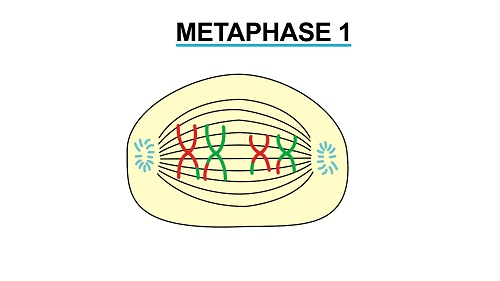
Diagram of metaphase
ANAPHASE
During
anaphase the centromere splits and the sister chromatids separate from
each other (see figure below). Once the sister chromatids separate from
each other, each is referred to as chromosome. It follows, therefore,
that at this stage the chromosome number in the cell has doubled. Then
the chromosomes begin to move towards opposite sides of the cell. The
movement is in such a way that an equal number of chromosomes move to
each pole of the cell.
anaphase the centromere splits and the sister chromatids separate from
each other (see figure below). Once the sister chromatids separate from
each other, each is referred to as chromosome. It follows, therefore,
that at this stage the chromosome number in the cell has doubled. Then
the chromosomes begin to move towards opposite sides of the cell. The
movement is in such a way that an equal number of chromosomes move to
each pole of the cell.
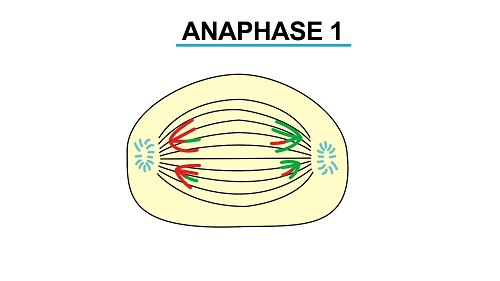
TELOPHASE
Telophase
begins when chromosomes reach the poles of the daughter cells. Many
events in the telophase are the reverse of prophase. The chromosomes
uncoil the nuclear membranes around daughter nuclei appear, the spindle
apparatus break down and the nucleus reappears and nuclear membrane
forms around each mass of chromosomes.
begins when chromosomes reach the poles of the daughter cells. Many
events in the telophase are the reverse of prophase. The chromosomes
uncoil the nuclear membranes around daughter nuclei appear, the spindle
apparatus break down and the nucleus reappears and nuclear membrane
forms around each mass of chromosomes.

CYTOKINESIS
Telophase
is followed by a stage calledcytokinesis. This is the division of
cytoplasm. In plant cells a delicate membrane called a cell plate starts
to form in the middle of the cell. Finally a new cell wall forms on
either side of the plate. In this way, two new daughter cells are
formed. In animals cells the cell membrane pinches the cytoplasm at the
middle of the cell until two daughter cells are formed. Cytokinesis is
completed as telophase ends.
is followed by a stage calledcytokinesis. This is the division of
cytoplasm. In plant cells a delicate membrane called a cell plate starts
to form in the middle of the cell. Finally a new cell wall forms on
either side of the plate. In this way, two new daughter cells are
formed. In animals cells the cell membrane pinches the cytoplasm at the
middle of the cell until two daughter cells are formed. Cytokinesis is
completed as telophase ends.

The Significance of Mitosis in the Growth
Explain the significance of mitosis in the growth
SIGNIFICANCE OF MITOSIS IN GROWTH
- Mitosis results in the formation of two identical daughter cells
- The
daughter cells are also identical to the parent cells because each
daughter cell has the same number of chromosomes as that found in the
original cell - Mitosis enables an organism to increase in size and maintain the same number of chromosomes in its body cell
- Mitosis
is also important for the replacement of worn out or damaged cells
example in the lining of the gut and the surface of the skin
Mitosis
alone does not bring about growth, when the cell divides the two
daughter cells are initially only half the size of the parent cells.
alone does not bring about growth, when the cell divides the two
daughter cells are initially only half the size of the parent cells.
The new cells must take in more materials to form the additional cytoplasm to produce fully-grown cells.
Growth and Developmental Stages in Human
Growth and Development in Human being
Explain growth and development in human being
Growth
is irreversible increase in size. It is usually accompanied by cell
division. Growth can be shown by increase in mass, length, surface area
and numbers. Development refers to increase in complexity and
differentiation of tissues and organs.
is irreversible increase in size. It is usually accompanied by cell
division. Growth can be shown by increase in mass, length, surface area
and numbers. Development refers to increase in complexity and
differentiation of tissues and organs.
Human
growth and development are lifelong processes of physical, behavioural,
cognitive, and emotional growth and change. At every stage of life,
there are physical and psychological changes in the human body. The
process takes many years and a person goes through many different growth
stages to reach adulthood, the final stage of development. Although
every person experiences growth and development uniquely, the patterns
are similar for all humans as shown in the growth curve below. In this
particular graph, the selected growth parameter measured is height.
growth and development are lifelong processes of physical, behavioural,
cognitive, and emotional growth and change. At every stage of life,
there are physical and psychological changes in the human body. The
process takes many years and a person goes through many different growth
stages to reach adulthood, the final stage of development. Although
every person experiences growth and development uniquely, the patterns
are similar for all humans as shown in the growth curve below. In this
particular graph, the selected growth parameter measured is height.
The Stages of Human Post–natal Growth and Development
Explain the stages of human post–natal growth and development
Growth
and development in humans can be prenatal or postnatal. Prenatal growth
and development takes place in the womb before a baby is born. Post
natal growth and development occurs after the baby is born.
and development in humans can be prenatal or postnatal. Prenatal growth
and development takes place in the womb before a baby is born. Post
natal growth and development occurs after the baby is born.
Even
though the terms growth and development are used interchangeably, there
are specific differences between them. We can sum up the differences
between growth and development in the following table.
though the terms growth and development are used interchangeably, there
are specific differences between them. We can sum up the differences
between growth and development in the following table.
| Growth | Development |
| Growth refers to increase in size, height, weight etc. | Development refers to improvement in the functioning of the body process |
| Easily measured and observed | Cannot be measured easily |
| It is limited. Starts with birth to reach the maximum at maturity | A continuous, unending process all through life. |
| Limited to specific areas | Concerned with various aspects and parts of body and behaviour as a whole |
| Quantitative change | Qualitative and Quantitative change |
Human beings and other mammals show limited growth.
Limited growth is growth that ceases at maturity. In these cases,
therefore, the growth curve flattens or even declines prior to death.
The decline is due to decline in smooth functioning of the organism,
culminating to death. This is called senescence.
Limited growth is growth that ceases at maturity. In these cases,
therefore, the growth curve flattens or even declines prior to death.
The decline is due to decline in smooth functioning of the organism,
culminating to death. This is called senescence.
Other mammals and plants grow throughout their lives. This type of growth is called unlimited growth.
Lymph
tissue grows very fast in early human life so that it produces a lot of
white blood cells to fight infection (because the immune system is not
able to fight infection). This type of growth in which organs grow at
different rates is called allometric growth.
tissue grows very fast in early human life so that it produces a lot of
white blood cells to fight infection (because the immune system is not
able to fight infection). This type of growth in which organs grow at
different rates is called allometric growth.
The
post-natal period is a period beginning immediately after the birth of a
child. The human post-natal growth and development may be divided into
five phases or stages. These different stages of post-natal growth are
summarised in the table below:
post-natal period is a period beginning immediately after the birth of a
child. The human post-natal growth and development may be divided into
five phases or stages. These different stages of post-natal growth are
summarised in the table below:
| S/No | Stage | Age span |
| 1 | Infancy | From birth to two years |
| (i) | Neonatal | From birth to 4 weeks |
| (ii) | Older baby | From 6 to 12 months |
| (iii) | Toddler | From 1 to 3 years |
| 2 | Childhood | From 3 to 12 years |
| (i) | Early childhood | From 3 to 6 years |
| (ii) | Late childhood | From 7 to 12 years or in strict sense up to the onset of puberty |
| (iii) | Pre-adolescence | From 10 to 11 years |
| 3 | Adolescence | From 13 to 19 years or in a strict sense from onset of puberty till the attainment of maturity |
| 4 | Adulthood | From 20 to 60 years or in strict sense from attaining maturity to the age one ceases to produce one’s own kind |
| (i) | Early adulthood | From 20 to 40 years |
| (ii) | Late adulthood | From 40 to 60 years |
| 5 | Old age or ageing (senescence) | From 60 years or in a strict sense from the end of the reproduction capability stage till death |
NOTE: The
age spans at which different stages of human growth and development
occur are very confusing! So don’t stick your mind to the age spans
because there are no defined ages at which each stage exactly occurs.
For example, the term infant is typically applied to young children
between the ages of 1 month and 12 months; however, definitions may vary
between birth and 1 year of age, or even between birth and 2 years of
age. The same case applies to the definition of a toddler. There is
simply no consensus about what constitutes a toddler. That said, rough
estimates about when toddlerhood begins vary greatly and are widely
accepted in the medical literature. Some will define a toddler as an
infant between the ages of 1 and 3. However, some literatures define a
toddler as an infant between 1 and 2 years. Confusing!
age spans at which different stages of human growth and development
occur are very confusing! So don’t stick your mind to the age spans
because there are no defined ages at which each stage exactly occurs.
For example, the term infant is typically applied to young children
between the ages of 1 month and 12 months; however, definitions may vary
between birth and 1 year of age, or even between birth and 2 years of
age. The same case applies to the definition of a toddler. There is
simply no consensus about what constitutes a toddler. That said, rough
estimates about when toddlerhood begins vary greatly and are widely
accepted in the medical literature. Some will define a toddler as an
infant between the ages of 1 and 3. However, some literatures define a
toddler as an infant between 1 and 2 years. Confusing!
Physiological, Psychological and Behaviour Changes Associated with Growth and Development
Explain physiological, psychological and behaviour changes associated with growth and development
In
each of the above stages, various physiological, psychological and
behavioural changes take place. The changes that occur in each stage are
explained in detail below:
each of the above stages, various physiological, psychological and
behavioural changes take place. The changes that occur in each stage are
explained in detail below:
Infancy
An
infant (from the Latin word infans, meaning “unable to speak” or
“speechless”) is the very young offspring of a human or animal. When
applied to humans, the term is usually considered synonymous with baby,
but the latter is commonly applied to the young of any animal. When a
human child learns to walk, the term toddler may be used instead.
infant (from the Latin word infans, meaning “unable to speak” or
“speechless”) is the very young offspring of a human or animal. When
applied to humans, the term is usually considered synonymous with baby,
but the latter is commonly applied to the young of any animal. When a
human child learns to walk, the term toddler may be used instead.
Infancy
is a period from 0-2 years. The child undergoes physical growth at a
rapid rate, greater than he will never experience subsequently. It is
interesting to know the changes that take place in the first two years.
Children at this stage are very active learners. During this period the
baby’s physiological processes become operative and fairly well
adjusted.
is a period from 0-2 years. The child undergoes physical growth at a
rapid rate, greater than he will never experience subsequently. It is
interesting to know the changes that take place in the first two years.
Children at this stage are very active learners. During this period the
baby’s physiological processes become operative and fairly well
adjusted.
The infancy stage is divided into three sub-categories: (i) neonatal, (ii) older baby, and (iii) toddler.
Neonatal
Neonatal stage is the stage from birth up to 4 weeks. New babies are also called neonates.
Physical and physiological changes
- At
this stage babies are helpless but can behave in a number of ways such
as crying, moving their arms, legs and head. They can also stretch and
make other movements. Baby movements are called reflexes. Examples of
reflexes include moving arms, legs, and head, swallowing, and sucking. - Babies at this stage suck anything put in their mouths. They can also grasp objects put in their hands.
- Neonates
can see, but only a short distance of about 20cm. They can also hear,
smell and feel. They spend most of their time sleeping. - The
shape of a neonate changes significantly from birth to 4 months.
Initially, the head and the abdomen are bigger compared to other body
parts. The body becomes proportional as the baby grows up. - The immune system is immature and the baby depends on the immunity from his or her mother through breast–feeding.
- The baby can sit with support and can respond to sounds, for example, smiling upon hearing her mother’s voice.
- The rate of heart beat at this stage is very high.
Behavioural and psychological changes:Babies
at this stage express their feelings mainly through crying. They cry to
show hunger, thirst, pain, tiredness, fear and discomfort such as wet
nappies, cold, a lot of heat, and sickness.
at this stage express their feelings mainly through crying. They cry to
show hunger, thirst, pain, tiredness, fear and discomfort such as wet
nappies, cold, a lot of heat, and sickness.
Older baby
This is the stage from 6 to 12 months.
Physical and physiological changes
- At six months a baby can completely control his/her head and sit without support. They can also roll over.
- At
7 months the baby learns to crawl. The baby can use his or her hands to
throw and point at things he or she wants using his or her index
finger. - He or she can hold and drop objects and stand while holding things like tables or chairs.
- Teething occurs at this period.
- From 9 to 12 months the baby starts to walk.
- At this stage the sight has improved and the baby can focus on far objects and can recognize people at a distance.
Behavioural and psychological changes:The
baby responds to his or her own name and other words that are familiar
to him. Social development also occurs at this period. For example, at 9
months, a baby can distinguish strangers from familiar people. At 1
year, he or she understands and obeys simple commands like “come”, “go”,
“stop”, etc.
baby responds to his or her own name and other words that are familiar
to him. Social development also occurs at this period. For example, at 9
months, a baby can distinguish strangers from familiar people. At 1
year, he or she understands and obeys simple commands like “come”, “go”,
“stop”, etc.
Toddler
This is the age between 1 to 3 years.
Physical and physiological changes
- Brain develops by 90%.
- The rate of heart beat is reduced to about 90-110 times per minute.
- The child is able to control urination and defecation as urinary and anal sphincter control become possible.
- Immune system becomes mature.
- The baby can see everything that an adult can see.
- The baby shows sense of colour.
- All the 20 milk teeth appear by the age of 2.5 to 3 years
- Hearing has developed well.
Psychological and behavioural changes
- At
12 to 14 months, the child uses gestures to express his or her
feelings, for example, raising arms when he or she wants to be picked
up. - At 15 months, the child copies what adults do. For example, a
child may imitate cooking by taking a spoon and stirring it in a bowl. - At
15 to 18 months, a child feeds himself or herself, addresses others
with greetings, climbs onto furniture, for example bed or couch and
speaks a few words. - At 19 to 24 months, a child likes to play
with other children (socialization), he or she can dress and undress
himself or herself, run or climb steps and wants to be independent at
times. He or she throws a tantrum (angry) or possibly says “No”. The
child has also increased his or her vocabulary up to 50 words and starts
toilet training. He or she mimics social behaviours such as holding and
feeding a toy. - At 25 to 36 months, a child can play with other
children and share playing toys, can speak in a sentence, is more
independent, can differentiate boys from girls, shows preferences such
as clothes and type of toys or games and knows how to play different
games. Emotionally, children may feel jealousy, for example, towards a
newborn baby. They also show fear for particular things for instance
fear of some insects and fear of the dark or scary noise like thunder.
Childhood
Childhood
is a period from 3 years to 12 years. The stage may be divided into
three stages: (i) early childhood (ii) late childhood and (iii)
pre-adolescence.
is a period from 3 years to 12 years. The stage may be divided into
three stages: (i) early childhood (ii) late childhood and (iii)
pre-adolescence.
Early childhood
The
early childhood years, 3-6 years of age, represent a remarkable period
of physical and psychological developments. It is a period when true
personality begins but physical development proceeds at a slower rate.
Here children become more self sufficient, acquire language, become a
part of the group, become more co-ordinated and obtain a higher degree
of self control. At this stage, children go to kindergarten.
early childhood years, 3-6 years of age, represent a remarkable period
of physical and psychological developments. It is a period when true
personality begins but physical development proceeds at a slower rate.
Here children become more self sufficient, acquire language, become a
part of the group, become more co-ordinated and obtain a higher degree
of self control. At this stage, children go to kindergarten.
Physical and physiological changes
- A
child has good appetite and therefore grows rapidly. Good appetite is
important as children at this age are very active and play a lot. - The child can identify up to five colours.
- Motor
coordination has developed well, and therefore the child can walk, jump
and skip. Fine motor skills have also developed and the child can draw
simple figures.
Psychological changes
- The child is very curious and imaginative.
- He or she understands right and wrong.
- He or she is curious about sexuality.
- The child can speak fluently, and can tell his or her age and name and a simple story.
Late childhood
The
stage of late childhood starts from the 7th year and goes on till the
12th year. You have already gone through this period. Can you list some
of the characteristics of this period?
stage of late childhood starts from the 7th year and goes on till the
12th year. You have already gone through this period. Can you list some
of the characteristics of this period?
During
this period, physical growth continues at a lower rate but intellectual
and emotional developments are rapid and very complex as the child
moves from home to the outside world. He begins to acquire basic skills
of formal learning and develops certain social activities. During the
greater part of late childhood, the child’s physical growth continues,
but at a slower rate until it shows a sudden spurt as the child
approaches adolescence. He is more attached to his peer groups and
interested in social and group activities. During this period, school
tasks contribute intellectual developments too. This is the age from 7
to 9 years. At this stage children are in primary school.
this period, physical growth continues at a lower rate but intellectual
and emotional developments are rapid and very complex as the child
moves from home to the outside world. He begins to acquire basic skills
of formal learning and develops certain social activities. During the
greater part of late childhood, the child’s physical growth continues,
but at a slower rate until it shows a sudden spurt as the child
approaches adolescence. He is more attached to his peer groups and
interested in social and group activities. During this period, school
tasks contribute intellectual developments too. This is the age from 7
to 9 years. At this stage children are in primary school.
Physiological and physical and changes
- Growth remains steady
- Children are very active
Psychological and behavioural changes
- The child can assume simple responsibilities like looking after the house when parents are not at home.
- The child is very social and likes to socialize and belong to groups
- He or she can help with household duties like washing dishes, setting the table and fetching water.
- The child likes to associate with peers of similar interest.
- This is the time children have friends and best friends. However they prefer friends of the same sex.
- Children at this stage can listen to peer’s opinion, but still value opinions of their parents
Pre-adolescence
This is the age from 10 and 11 years
Physical and physiological changes
- Growth starts to increase
- Appetite increases
- Secondary sexual characteristics start to show, for example, growth of breasts and growth of pubic hair and armpit hair.
Psychological changes
- Children still prefer friends of the same sex
- They start to become independent from the family.
- Children are very social and tend to value peers, opinions.
Services required to meet the needs of Children
The
services required to meet the needs of a child can be categorized into
two: essential or basic services, and supportive services. Essential or
basic services are necessary for a baby’s survival. Supportive services
are services that will help a child to grow well socially, emotionally
and mentally.
services required to meet the needs of a child can be categorized into
two: essential or basic services, and supportive services. Essential or
basic services are necessary for a baby’s survival. Supportive services
are services that will help a child to grow well socially, emotionally
and mentally.
Supportive
services include love, care and comfort, security, and training of
habits and skills. Older children need to be disciplined, trained to be
independent and useful to others and be responsible.Basic services
include healthy food, warmth, shelter, clothing, protection against
illness and injury, exercise and rest.
services include love, care and comfort, security, and training of
habits and skills. Older children need to be disciplined, trained to be
independent and useful to others and be responsible.Basic services
include healthy food, warmth, shelter, clothing, protection against
illness and injury, exercise and rest.
- Healthy food:Well-balanced
nutrition plays a major role in the growth of children. Healthy and
well-balanced food should be given to children for good physical and
mental growth.The improvement of strength, height, growth of muscle,
bone tissue and body resistance is completely dependent on the diet that
children eat. Children need balanced diet; they need to feed on food
rich in proteins, vitamins, minerals, carbohydrates, fibre and fat in
adequate proportions.Children are normally addicted to junk food, which
only harms their young bodies. Bad food habits at this age can make
children obese, more prone to heart diseases and other major health
risks.Parents should make sure that their children are fed on
energy-giving foods as well as vitamins, minerals and proteins. Children
should not be provided with junk food which contains harmful
cholesterol and fat that can impair the baby’s health. - Protection against illness and injury:Some
diseases and injuries may affect babies before they are born, at birth,
or after birth. These may affect some parts of the body like the brain
such that the child may become paralyzed or mentally retarded.
Blindness, for instance may affect the development of physical and
social capabilities of children. There are medical cases where diseases
and injuries have caused a great deal of disabilities to children.
Babies need to be immunized against some prevalent diseases such as
tuberculosis, measles and polio. - Exercise and rest:A
child’s body also needs exercise. Exercise makes muscles strong. It
also improves flexibility and makes the heart, lungs and other body
parts work efficiently. Playing is a form of exercise. While the body
needs exercise, it also needs rest. Muscles get tired when they are
overworked. Sleep is a form of rest for babies. Children need enough
sleep for proper growth. - Warmth:Babies
need warmth for proper functioning of their bodies. If babies are kept
in places that are too cold, they suffer from hypothermia. If kept in
too hot environment, they may develop heat rush and dehydration, and may
even die. Therefore, adequate warmth is important for proper growth and
development of children. - Shelter:Children
need a home where they can live, be nurtured, play, and be protected
against harsh environmental conditions such as cold and rain. The home
should be spacious, clean and safe.
Adolescence
Adolescent
period follows late childhood and extends from the age of 13 to 19.
Normally, girls reach adolescence earlier than boys of their age. Very
often it is called the awkward age because of awkwardness, clumsiness
and accompanying self consciousness which occurs frequently. During this
time physical, mental, emotional and social developments are complete.
It is considered as the last step in the long period of development
which begins at the time of conception. By the end of adolescence, the
individual is considered legally and socially matured. He is capable of
living an independent life free from supervision and guidance.
period follows late childhood and extends from the age of 13 to 19.
Normally, girls reach adolescence earlier than boys of their age. Very
often it is called the awkward age because of awkwardness, clumsiness
and accompanying self consciousness which occurs frequently. During this
time physical, mental, emotional and social developments are complete.
It is considered as the last step in the long period of development
which begins at the time of conception. By the end of adolescence, the
individual is considered legally and socially matured. He is capable of
living an independent life free from supervision and guidance.
Physical changes in an adolescent
During
adolescence, the bodies of both girls and boys produce hormones which
control many physical changes. These changes include the following:
adolescence, the bodies of both girls and boys produce hormones which
control many physical changes. These changes include the following:
- Rapid growth in weight and height.
- They become very energetic and active.
- Hair grows in armpits and groins of both boys and girls. Boys also grow beards and some grow hair on their chests.
- Girls
start to get the menstrual flow (monthly period). Initially the flow is
irregular, that is, it may not occur every month but after a few months
it starts appearing every month. - The breasts also start to grow
bigger in girls. The monthly period onset in girl marks the puberty
stage which indicates that such as person is able to become a parent.
This is why girls even below 12 years of age become pregnant because
they produce mature ova. - Boy’s sex organs enlarge and they
occasionally emit some fluid from the penis at night (wet dreams). Wet
dreams indicate that the boy has reached puberty and is capable of
becoming a parent. Puberty onset is the beginning of adolescent stage. - Boys deepen their voice gradually while girl voices become mellow.
- Some adolescents (boys or girls) develop pimples (acne) on the face but the pimples clear later on.
Psychological and behaviour changes at puberty
- Adolescence is characterized by a number of physiological, psychological and behaviour changes.
- The
changes can be a cause of conflict on one hand and positive personality
development on the other hand. For example, adolescents tend to view
their friends and peers as more important and influential than their
parents, guardians, teachers or elders. - Positive personality
development includes opportunity to develop various social skills, such
as empathy, sharing, leadership by peers and positive influences on an
individual, for instance on academic motivation and performance. - When
adolescence is not handled properly, negative influences such as
experimentation with drugs, alcoholism and stealing may occur.
Susceptibility to peer pressure increases during early adolescence but
it peaks at around age 14 and declines thereafter. - Onset of
puberty is also characterized by sexuality and sexual desire. Therefore
education on reproductive health is very important at this stage as
adolescents may find themselves contracting sexually transmitted
diseases, HIV and early pregnancies.
Personal hygiene during adolescence
- As
stated above, adolescents are very active and energetic and are thus
bound to sweat a lot. It is important that they bathe daily and change
into clean clothes. - When bathing, one must pay extra attention to genitals, armpits and areas between the toes.
- If
the armpits sweat a lot, shave the pubic hair to reduce warmth and
sweating. After bathing, apply deodorant to kill germs and prevent foul
smell (there are deodorant for men too). For sweaty feet, clean between
the toes, dry well and, if it can be afforded, dust the areas with
talcum powder. The powder absorbs the sweat, prevents bad smell and
athlete’s foot. - In case acne strikes, it should not worry
anybody. Avoid breaking the pimples but just: (i) keep the face clean;
(ii) avoid applying oil creams; and (iii) avoid diet that contains a lot
of oil. - With time, acne disappears on its own. Breaking the
pimple can cause black spots or infection. If it worries the individual
to a point of wishing to have it treated, it is wise to consult a
doctor. - At this stage avoid harsh creams as they may react with
the hormones and lead to damaged skin. Boys need to keep their beards
shaved. Girls need to bathe more than once during the menstrual flow to
avoid foul smell of blood. They need to wear sanitary towels to avoid
staining their clothes with blood. The sanitary towels must be changed
regularly to avoid development of foul smell and growth of germs. If
commercial sanitary towels cannot be afforded, home-made pads can be
prepared with cotton wool covered with gauze or just folding
Services required to meet the needs of adolescents.
Adolescents
require healthy food for their growing bodies. They also require a
peaceful home, security, emotional support, counselling, physical
exercise and social skills that will help them resist temptations from
peers and live a better and accepted lifestyle.
require healthy food for their growing bodies. They also require a
peaceful home, security, emotional support, counselling, physical
exercise and social skills that will help them resist temptations from
peers and live a better and accepted lifestyle.
Adulthood
Adulthood
starts at 20-60 years. It is the longest period of the life span.
During this stage physical developments are fairly complete. But
psychological adjustments continue throughout the entire stage. Choosing
a life partner, establishing a family, becoming a useful and productive
member, etc. are crucial during adulthood. One’s personality and
achievements are determined by the kind of experiences he has had during
his early years of life. Adulthood can be categorized into early
adulthood, middle adulthood and old age.
starts at 20-60 years. It is the longest period of the life span.
During this stage physical developments are fairly complete. But
psychological adjustments continue throughout the entire stage. Choosing
a life partner, establishing a family, becoming a useful and productive
member, etc. are crucial during adulthood. One’s personality and
achievements are determined by the kind of experiences he has had during
his early years of life. Adulthood can be categorized into early
adulthood, middle adulthood and old age.
Early adulthood
Early
adulthood (also called “emerging adulthood”) is a stage of life between
20 and 40 years, when adolescents become more independent and explore
different life possibilities. Early adulthood is also called young adulthood stage.
adulthood (also called “emerging adulthood”) is a stage of life between
20 and 40 years, when adolescents become more independent and explore
different life possibilities. Early adulthood is also called young adulthood stage.
Changes during early adulthood
- Growth
has stopped, only maintenance of body parts, for example, repair of
worn out cells takes place. A person may gain weight due to deposit of
fats but not due to growth and development. - A this stage, people
are in their best physical conditions, that is very strong, energetic,
have good memory capacity, sharp senses, and stamina. - Performance of the body system is very high.
- People
at this stage are very ambitious and want to succeed. They work hard to
meet their goals, for example to finish studies, get a decent job and /
or start a family - They are selective in terms of choosing occupations or partners.
- They have the desire to be socially independent.
Middle adulthood
Middle
or late adulthood starts at 40 years and ends at 60 years. Initially, a
person is still very strong and able to do tasks that require a lot of
energy.
or late adulthood starts at 40 years and ends at 60 years. Initially, a
person is still very strong and able to do tasks that require a lot of
energy.
The
performance of body stems is still high. Later, in the late forties or
early fifties, the rate of deterioration becomes significant. The
ability to do tasks that require a lot of energy and high speed
decrease, sharpness of vision decreases and memory loss may occur.
performance of body stems is still high. Later, in the late forties or
early fifties, the rate of deterioration becomes significant. The
ability to do tasks that require a lot of energy and high speed
decrease, sharpness of vision decreases and memory loss may occur.
Hair starts to turn grey, skin starts to loose elasticity. Women reach menopause and their desire to have sex is reduced.
Old Age
Old
age starts from 60 years and over. It is considered as the final stage
of the normal life span. During this period many physical, social,
emotional and behavioural changes take place. Some men and women
manifest signs which are associated with old age from their 60’s
onwards. These aging years demand a higher degree of emotional
adjustments.
age starts from 60 years and over. It is considered as the final stage
of the normal life span. During this period many physical, social,
emotional and behavioural changes take place. Some men and women
manifest signs which are associated with old age from their 60’s
onwards. These aging years demand a higher degree of emotional
adjustments.
There
are certain problems of adjustments such as physical and economic
dependency, establishing new contacts and interests and activities to
occupy increased leisure time. Psychological hazards during this stage
include feelings of inferiority and inadequacy resulting from physical
changes in life patterns, feeling of guilt about sitting idle and
reduced income that necessitates changes in living patterns. Financial
worries and ill health are common among this age.
are certain problems of adjustments such as physical and economic
dependency, establishing new contacts and interests and activities to
occupy increased leisure time. Psychological hazards during this stage
include feelings of inferiority and inadequacy resulting from physical
changes in life patterns, feeling of guilt about sitting idle and
reduced income that necessitates changes in living patterns. Financial
worries and ill health are common among this age.
As a person ages, various changes occurs in his or her body until her or she dies. Some of these changes are explained below:
- Decreased blood flow to the brain and death of nerve cells.
- The ability to focus on objects, smell and hear decreases.
- Hair
turns grey as a result of reduced production of hair pigment. The hair
also becomes thinner. Some men may develop a bald head. - Kidney functioning slows down and the frequency of urination increases.
- Digestion slows down especially for those who get poor diet.
- Elasticity of the skin decreases. The skin gets looser and wrinkles develop.
- Bones may become weak, especially for those who have been taking food with less calcium in young age.
- Men delay getting an erection.
- By the age of 70, about two thirds of taste buds in the mouth die, making a person fell like food is tasteless.
The
above features do not apply to all aged people. Healthy life style
during young age may delay occurrence of the above features and make a
person lead a normal life even in older age.A healthy life style is
achieved by eating healthy food, avoiding smoking, alcoholism,
overeating, drug abuse, excessive noise, toxic chemicals, stress and
inactivity.
above features do not apply to all aged people. Healthy life style
during young age may delay occurrence of the above features and make a
person lead a normal life even in older age.A healthy life style is
achieved by eating healthy food, avoiding smoking, alcoholism,
overeating, drug abuse, excessive noise, toxic chemicals, stress and
inactivity.
Services required to meet the needs of the elderly
Older
people need healthy food to strengthen their immune system and reduce
the rate of body deterioration. For very old people, the food should be
soft enough for them to chew, swallow and digest.
people need healthy food to strengthen their immune system and reduce
the rate of body deterioration. For very old people, the food should be
soft enough for them to chew, swallow and digest.
They
also need clean and comfortable clothing and a place to sleep and do
light physical exercise. They need love, care, and support. Love, care
and support help old people to avoid anger, loneliness and stress.
also need clean and comfortable clothing and a place to sleep and do
light physical exercise. They need love, care, and support. Love, care
and support help old people to avoid anger, loneliness and stress.
Factors
which Affect the Rate of Physical Deterioration of Human Body and
Services Required to Meet the Needs of an Individual at each Stage
which Affect the Rate of Physical Deterioration of Human Body and
Services Required to Meet the Needs of an Individual at each Stage
Outline
factors which affect the rate of physical deterioration of human body
and services required to meet the needs of an individual at each stage
factors which affect the rate of physical deterioration of human body
and services required to meet the needs of an individual at each stage
Some
people may live a happy, health life up to their old age and until they
die. Others get very old while they are still young.
people may live a happy, health life up to their old age and until they
die. Others get very old while they are still young.
Some
of the factors affecting the rate of deterioration of the human body
are psychological. They include smoking, alcoholism, drug abuse, stress
and inactivity.
of the factors affecting the rate of deterioration of the human body
are psychological. They include smoking, alcoholism, drug abuse, stress
and inactivity.
Some
other factors are environmental. They include poor diet, excessive
noise, toxic chemicals and radiations, diseases, and infections. Other
factors are genetical, for example, the Werner’s syndrome.
other factors are environmental. They include poor diet, excessive
noise, toxic chemicals and radiations, diseases, and infections. Other
factors are genetical, for example, the Werner’s syndrome.
- Smoking:Smokers
suffer more illnesses such as cancer than non-smokers. Smoking can
cause lung cancer, cardiovascular disease, Chronic Obstructive Pulmonary
Disease (COPD), and stroke. Smoking leads to premature balding, skin
wrinkling and osteoporosis.Osteoporosis is a condition in which bones
become thin and fragile, leading to fractures, stooped posture,
breathing problems and back pain. - Alcoholism:The
ability to metabolize alcohol decreases with age. Prolonged use of
alcohol leads to damage of the central nervous system and brain and
increases the risk of heart stroke and breast cancer for
women.Alcoholism also increases the frequency of illnesses as it weakens
the immune system and causes kidney failure and osteoporosis. - Drug abuse:Drug abuse weakens the immune system and causes premature aging. It thus reduces life span.
- Stress:Stress
may cause heart problems and high blood pressure. It also causes
impairment of the immune system, thus making a person sick often. Other
problems that may result from stress are failure to sleep (insomnia),
fatigue, ulcers, headache and migraine. - Inactivity:Sedentary
work and inactivity such as spending a long time watching TV or doing
office work that involves sitting most of the time results in being
overweight and its associated risks. It also shortens life span.People
who are inactive have more chances of developing health problems such as
obesity and high blood pressure than those who are active. - Poor diet:Poor
diet includes both underfeeding and overfeeding. Underfeeding causes
malnutrition which reduces life span. Overfeeding leads to obesity and
diabetes. Obesity and diabetes cause premature aging. - Diseases and infections:Pathogens
produce toxins that accelerate deterioration. They also deprive our
bodies of the necessary nutrients needed for good health. - Chemicals and radiations:Some
chemicals such as those found in cosmetics, medicines, insecticides,
pesticides, foodstuffs and sprays may have adverse effects on the human
body.These chemicals speed up deterioration or shorten life span. Some
radiations, for example X-rays, may affect our lives by killing body
cells or causing deadly diseases like cancer. - Werner’s syndrome:Werner’s
syndrome is a very rare disease that causes rapid ageing after puberty,
such that a 20 or 30 year old person may look several decades old. It
is caused by gene mutation and is named after a German scientist, Otto
Werner, who described the syndrome.
Growth in Flowering Plants
The concept of seed Germination
Explain the concept of seed germination
Germination
is the process by which a plant grows from a seed. The most common
example of germination is the sprouting of a seedling from a seed of an
angiosperm or gymnosperm. Plant growth is said to be localized.
In this case, growth is restricted to certain fixed regions like root
tips and shoot tips. After the seed germinates, the embryo starts to
grow as indicated in the figure below. The figure shows growth of a bean
seedling between day 2 and 11.
is the process by which a plant grows from a seed. The most common
example of germination is the sprouting of a seedling from a seed of an
angiosperm or gymnosperm. Plant growth is said to be localized.
In this case, growth is restricted to certain fixed regions like root
tips and shoot tips. After the seed germinates, the embryo starts to
grow as indicated in the figure below. The figure shows growth of a bean
seedling between day 2 and 11.

Germination and growth of a bean seed
Changes which occur during seed Germination
Outline changes which occur during seed germination
There are changes that occur during seed germination. These are:
- Seed absorb water and enlarge
- Later on the testa bursts and the radicle emerges. The radicle continues to elongate and gives rise to many roots
- As the radicle elongates, the plumule is curved. At this stage, young plant is called a seedling.
Accompanying
these morphological changes are chemical changes which occur inside the
seed. As the seed absorbs water the foods are hydrolyzed into soluble
food. The starch stored in the cotyledons or endosperm is converted to
sugar by action of diastase. In some seeds, lipase catalyzes the
hydrolysis of fats to fatty acid and glycerol.
these morphological changes are chemical changes which occur inside the
seed. As the seed absorbs water the foods are hydrolyzed into soluble
food. The starch stored in the cotyledons or endosperm is converted to
sugar by action of diastase. In some seeds, lipase catalyzes the
hydrolysis of fats to fatty acid and glycerol.
It
is likely that glycerol is converted into sugars since it is not
detected in germinating seeds. The proteolyctic enzymes catalyze the
hydrolysis of proteins to amino acids.
is likely that glycerol is converted into sugars since it is not
detected in germinating seeds. The proteolyctic enzymes catalyze the
hydrolysis of proteins to amino acids.
During
germination a lot of energy is required. This energy is derived from
the stored food materials.It follows, therefore that as the seed
germinates its weight decreases. This is because the stored food is
being used. The decrease in weight continues until the seedling is
capable of photosynthesizing.
germination a lot of energy is required. This energy is derived from
the stored food materials.It follows, therefore that as the seed
germinates its weight decreases. This is because the stored food is
being used. The decrease in weight continues until the seedling is
capable of photosynthesizing.
Parts of a seed
A
seed is a structure formed after the fertilization of an ovule. A seed
contains the embryo of the plant. The embryo grows and develops into a
mature plant which produces more seeds. The embryo is made up of the
plumule, radicle and cotyledons. The plumule develops into a shoot. The
radicle develops into a root. The cotyledons have nutrients which are
utilized by the seed during germination.
seed is a structure formed after the fertilization of an ovule. A seed
contains the embryo of the plant. The embryo grows and develops into a
mature plant which produces more seeds. The embryo is made up of the
plumule, radicle and cotyledons. The plumule develops into a shoot. The
radicle develops into a root. The cotyledons have nutrients which are
utilized by the seed during germination.
Seeds
have either one or two cotyledons. A seed with one cotyledon is called a
monocotyledonous seed. Examples of monocotyledonous seeds are maize,
rice, millet and wheat. A seed with two cotyledons is called a
dicotyledonous seed. Examples are beans, peas and groundnuts
have either one or two cotyledons. A seed with one cotyledon is called a
monocotyledonous seed. Examples of monocotyledonous seeds are maize,
rice, millet and wheat. A seed with two cotyledons is called a
dicotyledonous seed. Examples are beans, peas and groundnuts
Seeds
sometimes have additional nutrient tissues in form of the endosperm.
The seed coat, also called testa, encloses the fertilized ovule. The
testa has a pore called the micropyle. The micropyle allows water and
air to get in and out of the seed.
sometimes have additional nutrient tissues in form of the endosperm.
The seed coat, also called testa, encloses the fertilized ovule. The
testa has a pore called the micropyle. The micropyle allows water and
air to get in and out of the seed.
On
the testa is a scar called the hilum. The hilum marks the point of
attachment to the funicle. The funicle attaches the seed to the placenta
on the ovary wall.The plumule has small leaves. The leaves are the
replica of natural leaves. A radicle is a replica of a mature root. The
testa is hard and encloses the seed, hence protecting it.
the testa is a scar called the hilum. The hilum marks the point of
attachment to the funicle. The funicle attaches the seed to the placenta
on the ovary wall.The plumule has small leaves. The leaves are the
replica of natural leaves. A radicle is a replica of a mature root. The
testa is hard and encloses the seed, hence protecting it.
The figures below show the parts of a monocotyledonous seed (maize) and a dicotyledonous seed (bean).
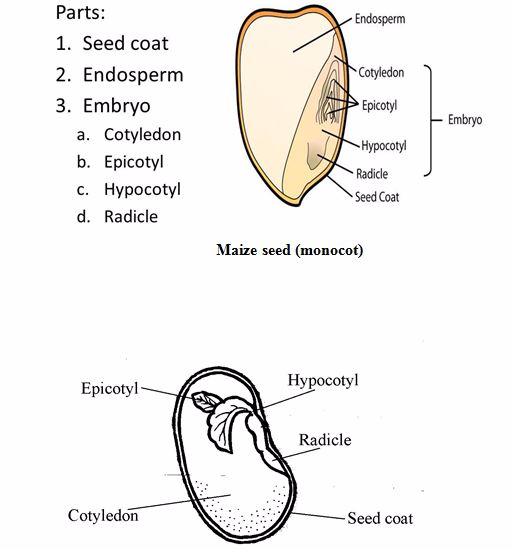
Conditions necessary for seed Germination
Investigate conditions necessary for seed germination
Seeds require certain conditions for them to germinate. These conditions are water, oxygen, optimum temperature and light.
Water
Water
is a solvent required for enzymatic activities. Water enters the seed
through the micropyle. The water softens the testa thus allowing the
seed to take in water. The osmotic pressure in the seed causes water to
enter the seed by osmosis. Pressure is created in the swollen seed,
rupturing the softened testa.
is a solvent required for enzymatic activities. Water enters the seed
through the micropyle. The water softens the testa thus allowing the
seed to take in water. The osmotic pressure in the seed causes water to
enter the seed by osmosis. Pressure is created in the swollen seed,
rupturing the softened testa.
The seeds require water for the processes outlined below:
- Activation
of enzymes: When seeds are formed, most plants store a food reserve
with the seed, such as starch, proteins, or oils. This food reserve
provides nourishment to the growing embryo. When the seed imbibes water,
hydrolytic enzymes are activated and break down these stored food
resources into metabolically useful chemicals. - Most seeds need
enough water to moisten them. The uptake leads to the swelling and the
breaking of the seed coat, which enables the embryo to emerge from the
cotyledon(s). - Water is used to dissolve food substances. The
food needs to dissolve so as to diffuse or get transported to the growth
parts of the embryo in the seed. - Water is needed for the
development of the cell sap vacuoles. Large cell sap vacuoles contribute
to the increase in the size of cells, hence, growth.
Oxygen
Oxygen
is required by the germinating seed for metabolism. It is used in
aerobic respiration, the main source of the seedling’s energy until it
grows leaves. Respiration produces energy for processes like cell
division and transport of food to growing regions.
is required by the germinating seed for metabolism. It is used in
aerobic respiration, the main source of the seedling’s energy until it
grows leaves. Respiration produces energy for processes like cell
division and transport of food to growing regions.
Oxygen
diffuses into the seed through the micropyle. The softened testa later
allows oxygen to diffuse directly into the tissues.
diffuses into the seed through the micropyle. The softened testa later
allows oxygen to diffuse directly into the tissues.
Optimum Temperature
Temperature
affects cellular metabolic and growth rates. Seeds from different
species and even seeds from the same plant germinate over a wide range
of temperatures. Seeds often have a temperature range within which they
will germinate, and they will not do so above or below this range. Many
seeds germinate at temperatures slightly above 16-24 °C.
affects cellular metabolic and growth rates. Seeds from different
species and even seeds from the same plant germinate over a wide range
of temperatures. Seeds often have a temperature range within which they
will germinate, and they will not do so above or below this range. Many
seeds germinate at temperatures slightly above 16-24 °C.
Temperature
is an important requirement for activation of enzymes. The enzymes in
the seed work best at optimum temperature since they are denatured by
high temperatures and inhibited by extremely low temperatures.
is an important requirement for activation of enzymes. The enzymes in
the seed work best at optimum temperature since they are denatured by
high temperatures and inhibited by extremely low temperatures.
Some
seeds may require to be first exposed to low temperatures before they
can germinate. This is usually the case in plants that grow in temperate
climates. The seeds need to go through winter before the onset of
spring when the seeds germinate.
seeds may require to be first exposed to low temperatures before they
can germinate. This is usually the case in plants that grow in temperate
climates. The seeds need to go through winter before the onset of
spring when the seeds germinate.
Light
The
requirement of light for germination varies from plant to plant. Some
plants need darkness while others need light in varying degrees.
requirement of light for germination varies from plant to plant. Some
plants need darkness while others need light in varying degrees.
Light
or darkness can be an environmental trigger for germination and is a
type of physiological dormancy. Most seeds are not affected by light or
darkness, but many seeds, including species found in forest settings,
will not germinate until an opening in the canopy allows sufficient
light for growth of the seedling.
or darkness can be an environmental trigger for germination and is a
type of physiological dormancy. Most seeds are not affected by light or
darkness, but many seeds, including species found in forest settings,
will not germinate until an opening in the canopy allows sufficient
light for growth of the seedling.
Types of seed germination
There are two types of seed germination namely, hypogeal germination and epigeal germination.
Epigeal germination
Epigeal
germination is a type of germination in which the cotyledons are
brought above the soil level. This type of germination is seen in many
dicotyledonous plants, such as beans, sunflower, castor, bean, etc. Some
monocotyledonous plants such as the onion also show epigeal
germination.
germination is a type of germination in which the cotyledons are
brought above the soil level. This type of germination is seen in many
dicotyledonous plants, such as beans, sunflower, castor, bean, etc. Some
monocotyledonous plants such as the onion also show epigeal
germination.
In
a dicotyledonous seed, the plumule and radicle are attached to the two
cotyledons. The hypocotyl elongates rapidly raising the cotyledons into
the air. The hypocotyl is the region of the stem beneath the cotyledons
and directly above the young root of a seedling. The epicotyl is the
region of the shoot of a seedling which is found above the cotyledon of
an embryo.
a dicotyledonous seed, the plumule and radicle are attached to the two
cotyledons. The hypocotyl elongates rapidly raising the cotyledons into
the air. The hypocotyl is the region of the stem beneath the cotyledons
and directly above the young root of a seedling. The epicotyl is the
region of the shoot of a seedling which is found above the cotyledon of
an embryo.
The
seed absorbs water and softens the testa. The cotyledons swell and
rupture the testa. The radicle elongates and emerges through the seed
coat. Roots develop from the radicle. The hypocoty elongates rapidly and
develops a curvature. The curved part emerges above the soil. The
hypocotyl eventually straightens, raising the cotyledons and the plumule
above the soil. The cotyledons are also referred to as seed leaves.
seed absorbs water and softens the testa. The cotyledons swell and
rupture the testa. The radicle elongates and emerges through the seed
coat. Roots develop from the radicle. The hypocoty elongates rapidly and
develops a curvature. The curved part emerges above the soil. The
hypocotyl eventually straightens, raising the cotyledons and the plumule
above the soil. The cotyledons are also referred to as seed leaves.
The
cotyledons enlarge and turn green to carry out photosynthesis. The
epicotyl elongates thus increasing the height of the seedling. The first
foliage leaves emerge. The cotyledons shrivel as the stored food
materials are used up. The first foliage leaves enlarge and start
carrying out photosynthesis.
cotyledons enlarge and turn green to carry out photosynthesis. The
epicotyl elongates thus increasing the height of the seedling. The first
foliage leaves emerge. The cotyledons shrivel as the stored food
materials are used up. The first foliage leaves enlarge and start
carrying out photosynthesis.
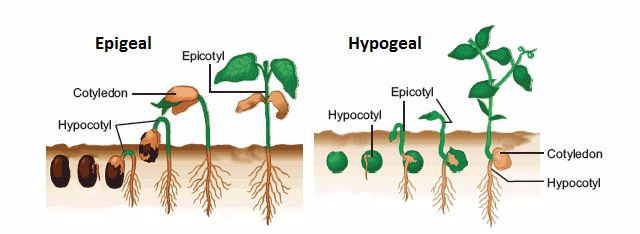
Epigeal and hypogeal germination
Hypogeal germination
Hypogeal
germination is a type of germination in which the cotyledons remain
underground. It occurs in plants such as maize, pigeon peas, wheat, etc.
germination is a type of germination in which the cotyledons remain
underground. It occurs in plants such as maize, pigeon peas, wheat, etc.
The
part of the embryo that elongates is the epicotyl. The epicotyl
elongates rapidly, raising the plumule above the soil. The cotyledons
remain below the ground level.
part of the embryo that elongates is the epicotyl. The epicotyl
elongates rapidly, raising the plumule above the soil. The cotyledons
remain below the ground level.
The
shoot is pushed through the soil particles. In maize, the plumule
sheath, known as the coleoptile, protects the plumule. The coleotile
grows towards light.
shoot is pushed through the soil particles. In maize, the plumule
sheath, known as the coleoptile, protects the plumule. The coleotile
grows towards light.
The
foliage leaves emerge through the split end of the coleoptile. The
foliage leaves carry out photosynthesis. The radicle is protected as it
emerges through the maize grain by a sheath called coleorhizae.
foliage leaves emerge through the split end of the coleoptile. The
foliage leaves carry out photosynthesis. The radicle is protected as it
emerges through the maize grain by a sheath called coleorhizae.
Practical activities to demonstrate Epigeal and Hypogeal Germination
Carry out practical activities to demonstrate epigeal and hypogeal germination
Growth regions of a seedling
The
growth of the radicle and the plumule causes the elongation of a
seedling. A radicle develops and forms the roots, while a plumule
develops and forms the shoot. The rate of growth can be measured at the
tip of the root or shoot.
growth of the radicle and the plumule causes the elongation of a
seedling. A radicle develops and forms the roots, while a plumule
develops and forms the shoot. The rate of growth can be measured at the
tip of the root or shoot.
Cells at the root and shoot apices have a high capacity to divide. The
dividing cells are called meristematic cells. The cells make up a tissue
called the apical meristem. These cells rapidly undergo mitosis, thus
enlarging and giving rise to more cells.
dividing cells are called meristematic cells. The cells make up a tissue
called the apical meristem. These cells rapidly undergo mitosis, thus
enlarging and giving rise to more cells.
The
very cells increase the size of the shoots and roots. The cells
differentiate to form tissues that carry out specific functions.
very cells increase the size of the shoots and roots. The cells
differentiate to form tissues that carry out specific functions.
The plant organs elongate, resulting in growth at the root and shoot apices. This type of growth is known as primary growth.
The
meristematic tissue at the shoot apex actively divides, leading to the
elongation of the shoot. The meristematic tissue also gives rise to
leaves. Leaf primordia, from which the leaves develop, occur at the
nodes of the shoots.
meristematic tissue at the shoot apex actively divides, leading to the
elongation of the shoot. The meristematic tissue also gives rise to
leaves. Leaf primordia, from which the leaves develop, occur at the
nodes of the shoots.
The
part of a stem between one node and the next is called the internode.
The axillary bud has meristematic tissue known as the intercalary
meristem. The meristem tissue brings about internode elongation.
part of a stem between one node and the next is called the internode.
The axillary bud has meristematic tissue known as the intercalary
meristem. The meristem tissue brings about internode elongation.
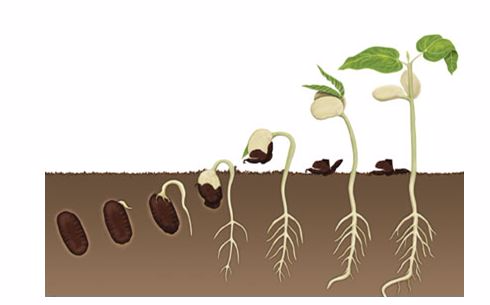













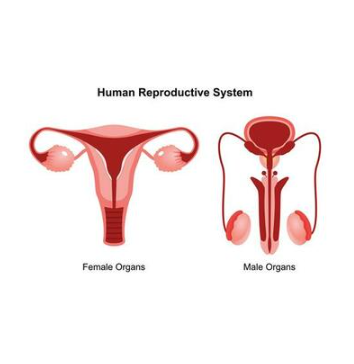
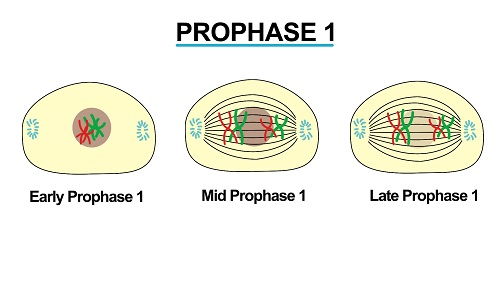





Its like you read my mind! You seem to know a lot about this, like you wrote the book in it or something.
I think that you could do with some pics to drive the message home a little bit, but instead of that, this is wonderful blog.
A fantastic read. I will definitely be back.
Hi there would you mind sharing which blog platform
you’re using? I’m going to start my own blog in the near future
but I’m having a difficult time deciding between BlogEngine/Wordpress/B2evolution and Drupal.
The reason I ask is because your design seems different then most blogs and I’m looking
for something completely unique. P.S My apologies for getting off-topic but I had to ask!
I every time spent my half an hour to read this web site’s content
all the time along with a cup of coffee.
As a Newbie, I am permanently searching online for articles that can be of assistance to me. Thank you